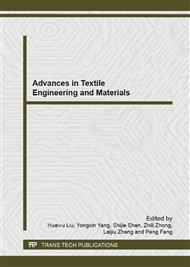p.3
p.15
p.19
p.23
p.29
p.33
p.37
p.43
A Study on the Structure and Properties of Pineapple Leaf Viscose Fiber
Abstract:
To develop a new kind of functional textile material, viscose fiber was prepared from natural and antibacterial pineapple leaf fiber and its structures and properties were explored with analyzing methods of sensory evaluation, SEM, FT-IR, TG, DTG and DSC. The results showed that the prepared pineapple leaf viscose fiber was white, shiny, fine, smooth, soft, and somewhat curly with even fineness. Its arrangement was verticall y parallel with some obvious grooves. Irregular zigzaging and the skin-core structure were observed in cross section. The fiber had characteristic groups of cellulose and absorption peaks at 1737.74, 1506.23 and 1431.82 cm-1 almost disappeared, and it showed high purity. The pyrogenation mechanism of pineapple leaf viscose fiber was similar to that of pineapple leaf fiber, but thermal stability of pineapple leaf viscose fiber was slightly lower than that of pineapple leaf fiber. Pineapple leaf viscose fiber belonged to cotton-type viscose staple fiber. The basic properties met the requirements of the first grade of viscose fiber. The mechanical properties reached top standard. It was a good kind of antibacterial textile material with strong bacteriostatic and bactericidal action against Staphylococcus aureus, Escherichia coli and Candida albicans.
Info:
Periodical:
Pages:
3-14
Citation:
Online since:
December 2012
Price:
Сopyright:
© 2013 Trans Tech Publications Ltd. All Rights Reserved
Share:
Citation:


